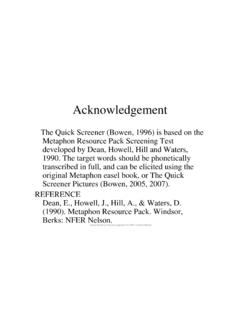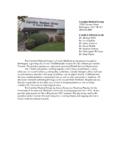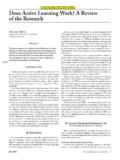Transcription of Phonological Processes in Typical Speech Development ...
1 6/15/11 10:20 PMTable 2: Phonological Processes in Typical Speech Development - Caroline BowenPage 1 of 2 MAPSTART PAGEABOUTDISCLAIMERPRIVACYCONTENTSLINKSE MAILCOPYRIGHT Phonological ProcessesCOPYRIGHT 1999 CAROLINE BOWEN All children make predictable pronunciation errors (not really 'errors' at all, when youstop to think about it) when they are learning to talk like adults. These 'errors' are calledphonological Processes , or Phonological deviations. In Table 2 are the commonphonological Processes found in children's Speech while they are learning the adultsound-system of English. TABLE 2: Phonological Processes in Typical Speech DevelopmentPHONOLOGICAL PROCESS( Phonological Deviation)EXAMPLEDESCRIPTIONC ontext sensitive voicing"Pig" is pronounced and "big""Car" is pronounced as "gar"A voiceless sound is replaced by avoiced sound.
2 In the examples given,/p/ is replaced by /b/, and /k/ isreplaced by /g/. Other examples mightinclude /t/ being replaced by /d/, or /f/being replaced by /v/.Word-final devoicing"Red" is pronounced as "ret""Bag" is pronounced as "bak"A final voiced consonant in a word isreplaced by a voiceless , /d/ has been replaced by /t/ and/g/ has been replaced by /k/.Final consonant deletion"Home" is pronounced a "hoe""Calf" is pronounced as "cah"The final consonant in the word isomitted. In these examples, /m/ isomitted (or deleted) from "home" and /f/is omitted from "calf".Velar fronting"Kiss" is pronounced as "tiss""Give" is pronounced as "div""Wing" is pronounced as "win"A velar consonant, that is a sound thatis normally made with the middle of thetongue in contact with the palatetowards the back of the mouth, isreplaced with consonant produced atthe front of the mouth.
3 Hence /k/ isreplaced by /t/, /g/ is replaced by /d/,and 'ng' is replaced by /n/.Palatal fronting"Ship" is pronounced as "sip""Measure" is pronounced as"mezza"The fricative consonants 'sh' and 'zh'are replaced by fricatives that are madefurther forward on the palate, towardsthe front teeth. 'sh' is replaced by /s/,and 'zh' is replaced by /z/.Consonant harmony"Cupboard" is pronounced as"pubbed""dog" is pronounced as "gog"The pronunciation of the whole word isinfluenced by the presence of aparticular sound in the word. In theseexamples: (1) the /b/ in "cupboard"causes the /k/ to be replaced /p/, whichis the voiceless cognate of /b/, and (2)the /g/ in "dog" causes /d/ to bereplaced by /g/.Weak syllable deletionTelephone is pronounced as"teffone""Tidying" is pronounced as"tying"Syllables are either stressed orunstressed.
4 In "telephone" and "tidying"the second syllable is "weak" orunstressed. In this phonologicalprocess, weak syllables are omittedwhen the child says the reduction"Spider" is pronounced asConsonant clusters occur when two orthree consonants occur in a sequence6/15/11 10:20 PMTable 2: Phonological Processes in Typical Speech Development - Caroline BowenPage 2 of 2 reduction"Spider" is pronounced as"pider""Ant" is pronounced as "at"three consonants occur in a sequencein a word. In cluster reduction part ofthe cluster is omitted. In theseexamples /s/ has been deleted form"spider" and /n/ from "ant".Gliding of liquids"Real" is pronounced as "weal""Leg" is pronounced as "yeg"The liquid consonants /l/ and /r/ arereplaced by /w/ or 'y'.
5 In theseexamples, /r/ in "real" is replaced by/w/, and /l/ in "leg" is replaced by 'y'.Stopping"Funny" is pronounced as"punny""Jump" is pronounced as "dump"A fricative consonant (/f/ /v/ /s/ /z/, 'sh','zh', 'th' or /h/), or an affricateconsonant ('ch' or /j/) is replaced by astop consonant (/p/ /b/ /t/ /d/ /k/ or /g/).In these examples, /f/ in "funny" isreplaced by /p/, and 'j' in "jump" isreplaced by /d/. ReferencesBowen, C. (1998). Developmental Phonological disorders. A practical guide for familiesand teachers. Melbourne: ACER , P. (1997). Natural phonology. In M. Ball & R. Kent (Eds.), The newphonologies: Developments in clinical linguistics. San Deigo: Singular Publishing Group,Inc. Table 1: Intelligibility to parents Table 3: Elimination of Phonological ProcessesTable 4: Phonetic DevelopmentSpeech intelligibility from 12 to 48 monthsQ&A: Speech Sound Disorders Page updated 23 Mar 2010 Caroline Bowen ALL RIGHTS RESERVED 6/15/11 10:21 PMTable 3: Elimination of Phonological Processes - Caroline BowenPage 1 of 2 MAPSTART PAGEABOUTDISCLAIMERPRIVACYCONTENTSLINKSE MAILCOPYRIGHT Phonological DevelopmentTHE GRADUAL ACQUISITION OF THE Speech SOUND SYSTEMCOPYRIGHT 1999 CAROLINE BOWEN TABLE 3: Elimination of Phonological ProcessesPhonological Processes are typically gone by these ages (in years ; months) Phonological PROCESSEXAMPLEGONE BY APPROXIMATELYC ontext sensitive voicingpig = big3;0 Word-final de-voicingpig = pick3;0 Final consonant deletioncomb = coe3.
6 3 Frontingcar = tarship = sip3;6 Consonant harmonymine = mimekittycat = tittytat3;9 Weak syllable deletionelephant = efantpotato = tatotelevision =tevisionbanana = nana4;0 Cluster reductionspoon = poontrain = chainclean = keen4;0 Gliding of liquidsrun = oneleg = wegleg = yeg5;0 Stopping /f/fish = tish3;0 Stopping /s/soap = dope3;0 Stopping /v/very = berry3;6 Stopping /z/zoo = doo3;6 Stopping 'sh'shop = dop4;6 Stopping 'j'jump = dump4;6 Stopping 'ch'chair = tare4;6 Stopping voiceless 'th'thing = ting5;0 Stopping voiced 'th'them = dem5;0 6/15/11 10:21 PMTable 3: Elimination of Phonological Processes - Caroline BowenPage 2 of 2 , C. (1998). Developmental Phonological disorders. Apractical guide for families and teachers. Melbourne: , P. (1997). Natural phonology. In M. Ball & R. Kent(Eds.), The new phonologies: Developments in clinicallinguistics.
7 San Deigo: Singular Publishing Group, Inc. Table 1: Intelligibility to parentsTable 2: Phonological ProcessesTable 4: Phonetic DevelopmentQ&A: Speech Sound DisordersSpeech intelligibility from 12 to 48 months Page updated 23 Mar 2010 Caroline Bowen ALL RIGHTS RESERVED

















